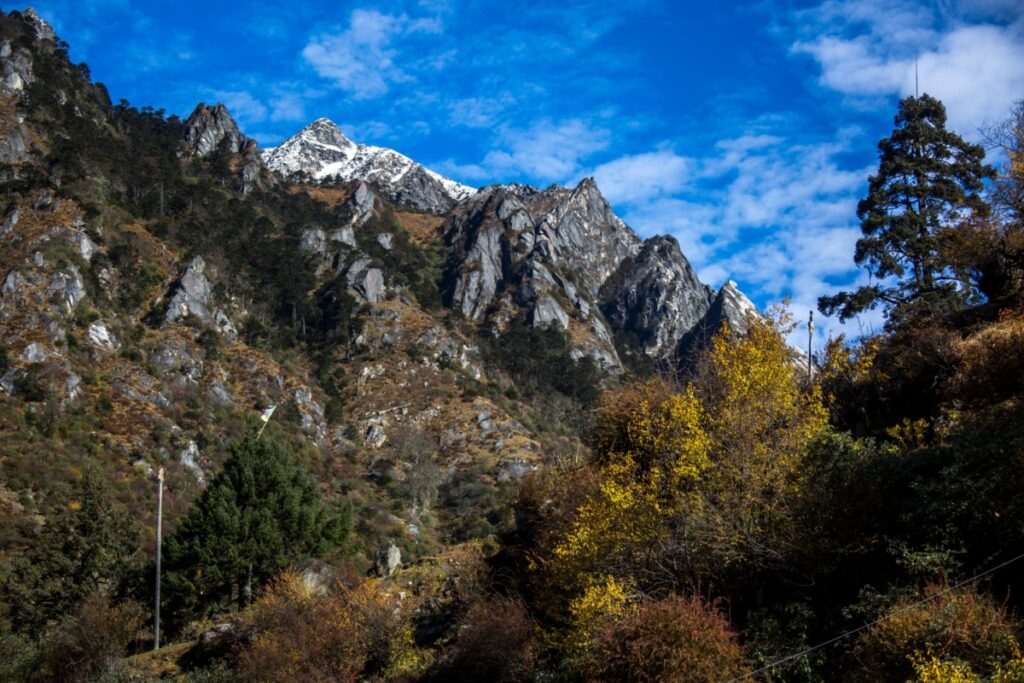Situated, close to the Indo-China border within the Thingbu circle/tehsil in the Tawang district of Arunachal Pradesh, Mago is an alpine retreat that stands at an elevation of 11,762 feet and offers an unspoiled glimpse into the high-altitude beauty of the Eastern Himalayas. Serving as the entryway to the lofty Gorichen Peak, the highest in the state, this village unfolds as a cradle in a wide river valley between highly eroded rocky peaks and arround the meandering Goshu Chu river.
The journey to Mago is an adventure in itself, with two distinct routes leading from Tawang, the main tourist hub in the Western Arunachal Pradesh.
Tawang to Mago via Jung, New Maling and Thingbu: Starting from New Maling, the newly constructed blacktopped road from Jung to Mago winds through a narrow gorge of the Mago Chu (River) with numerous waterfalls by its side and Thingbu village on its way. This mountain cave road, built on the edge of a cliff—cutting through the mountain in C-shaped caverns that remain open on one side with a river below or by its side—showcases the remarkable engineering skills of the Border Road Organisation and serves as the inaugural stretch of the proposed 2000 Km long Arunachal Pradesh Frontier Highway, tracing the India-China border from Mago in the west to Vijayanagar in the east.
Tawang to Mago via Damteng: Damteng, the gateway to Chumi Gyatse 108 Waterfalls—a newly opened attraction situated on the northeastern side of Tawang District—can be reached from Tawang town in a 3 to 4-hour journey, crossing several high-altitude mountain passes, including Bumla Pass. From Damteng, an offbeat high altitude mountain road winds through the highly glaciated terrain with snow-covered craggy mountain peaks along the Indo-Tibet border, traversing notable landmarks like Gongkar La (15700 ft), Lungla Post, and Chuna Post. Chuna Post, which also houses a small human settlement known as Mago Chuna Village, holds the distinction of being the first Indian village in Arunachal Pradesh from the side of the Indo-China Border. This high-altitude post is utilized by the Indian army on the Indo-Tibet Border and serves as a crucial link connecting Mago Village.
The Mago Chuna Valley, consisting another two villages—Chuna and Lungar along with Mago Village, and it’s surrounding areas, are home to narrow gorges, hidden caves, amazing rocky cliffs with grassy foothills, colorful alpine forests and waterfalls of different size revealing a landscape right from a fairy tale.
The high-altitude river valleys and gorges surrounding Mago Village, shaped by the rivers in the region—Goshu Chu, Dungma Chu, and Gorjo Chu, present a breathtaking spectacle. Towering cliffs adorned with rugged rock formations create an enchanting landscape, further enhanced by the presence of subalpine and alpine flora unique to the Eastern Himalayas. The turquoise waters of these rivers meander through the ravines, giving life to a botanical wonderland where vibrant rhododendrons, junipers, and wildflowers flourish. As you traverse the trails, keep an eye out for waterfalls of various sizes, cascading from lofty cliffs or gently flowing down from shorter heights, adding a rhythmic melody to the already captivating symphony of nature.
Navigating the enchanting river canyons of Mago Village, two trails emerge as exquisite and well-charted. The first, Mago to Jethang, traces the sinuous curves of the Dungma Chu river, revealing a picturesque journey. The second, Mago to Thingbu, weaves through the Mago Chu river, named after the convergence of three rivers at Mago Village.
One of the hidden treasures of Mago Village is the network of hot springs with highly medicinal value lining the riverbank of Goshuchu. Among them, the Topkey hot spring stands out as a true oasis. The crystal-clear water flows into a natural pool in generous volumes, offering an ideal temperature for a relaxing dip. Not only is it a rejuvenating experience for the body, but the hot spring is also known for its medicinal properties, adding an extra layer of therapeutic benefits to your visit. It’s a feast for the eyes, surrounded by the untouched beauty of the Himalayan landscape.

